Ijraset Journal For Research in Applied Science and Engineering Technology
- Home / Ijraset
- On This Page
- Abstract
- Introduction
- Conclusion
- References
- Copyright
“Formulation and Evaluation of Herbal Shampoo”
Authors: Waghmode Monika Vasant, Dr. Hingane L. D.
DOI Link: https://doi.org/10.22214/ijraset.2022.44982
Certificate: View Certificate
Abstract
The shampoo sector is probably the largest unit sale among the hair care products since shampoos are one of the cosmetic products used in daily life. Synthetic preservatives and detergents have sometimes been the cause of adverse effects among consumers. A more radical approach in reducing the synthetic ingredients is by incorporating natural extract whose functionality is comparable with their synthetic ingredients. A shampoo is a cleaning aid for the hair and is counted among the foremost beauty products. Today’s shampoo formulations are beyond the stage of pure cleaning of the hair. Additional benefits are expected, e.g., conditioning, smoothing of the hair surface, good health of hair, i.e., hair free of dandruff, dirt, grease and lice and, above all, its safety benefits are expected. As the scalp is one of the most absorbent part of the body, products applied to the scalp go directly to the blood, without being filtered in any way. In the scenario of changing food habits, stress level and dependent environment conditions, number of skin and hair disorders are encountered. This herbal shampoo was formulated using natural ingredient like Fenugreek seeds), Acacia concinna (shikakai), Sapindus mukorossi (reetha), Ocimum sanctum (tulsi), Aloe vera (aloe), Hibiscus rosa sinensis (china rose), Embelica officinalis (amla), Lawsonia inermis (henna),Citrus lemon (lemon), with proven efficacy of hair care preparation is prepared. The combination of several such ingredient of herbal origin has made it possible to secure highly effective dry powder shampoo. The formulation at laboratory scale was done and evaluated for number of parameters to ensure its safety and efficacy.
Introduction
I. INTRODUCTION
A liquid or cream preparation of soap or detergent to wash the hair is called as shampoo. Shampoo is a hair care product, typically in the form of a viscous liquid that is used for cleansing hair. The goal of using shampoo is to remove the unwanted build-up in between the hair without stripping out so much sebum as to make hair unmanageable Shampooing is the most common form of hair treatment. Shampoos are primarily being products aimed at cleansing the hair and scalp. In the present scenario, it seems improbable that herbal shampoo, although better in performance and safer than the synthetic ones, will be popular with the consumers. A more radical approach in popularizing herbal shampoo would be to change the consumer expectations from a shampoo, with emphasis on safety and efficacy. The word shampoo in English is derived from Hindustani shampoo. Shampoos are typically composed of 10 to 30 ingredients.
II. CLASSIFICATIONS OF SHAMPOO
A. Based on Appearance
Powder shampoo
Liquid shampoo
Gel shampoo
Oil shampoo
B. Based on use or Function
Conditioning shampoo
Antidandruff shampoo
Baby shampoo
Clarifying shampoo
C.Based on Origin
- Herbal Shampoo: Egg shampoo evaluation of shampoo comprises the quality control test including visual assesment and physiochemical control such as pH,density and viscosity.
2. Ideal Properties of Shampoo
a. To make the hair smooth and shiny.
b. Produce good amount of foam.
c. Should not cause irritant to scalp, skin and eye.
d. Should completely, effectively remove dirt.
e. Impart pleasant fragrance to hair.
D. Functions of Shampoo
a. It should effectively and completely remove dirt or soil.
b. It should effectively wash the hair.
c. It should produce a good amount of foam to satisfy the user.
d. It should be readily removed by rinsing with water.
e. It should impart a pleasant fragrance to the hair.
f.It should not have any side effects or causes irritation to the skin and eye
III. OBJECTIVE OF SHAMPOO
To formulate the herbal shampoo using an extract of amla, ritha,shikakai and understand the uses or application of the ingredients in day to day life .To evaluate the herbal shampoo prepared from the extract of amla ,ritha ,shikakai to understand the stability and applicability of the shampoo.To understand the advantages of herbal shampoo over chemical based shampoo and reduce side effect . To understand various applications.To study evaluation of herbal shampoo and effect on hair.
IV. INGREDIENTS
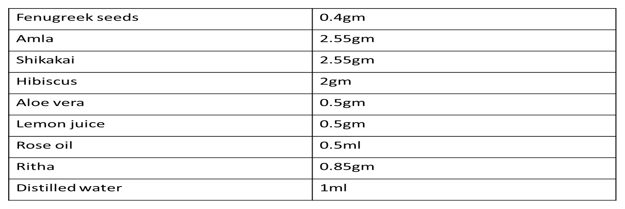
A. Use of Ingredient
- Fenugreek Seeds
Antimicrobial dandruff treatment
Revives damaged hair and induces hair growth
May reduce hair loss and shedding
Support healthy scalp
Prevent premature graying of hair
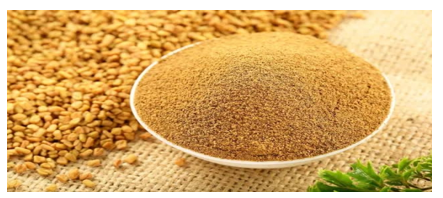
2. Amla
Strength the scalp and hair
Reduce premature pigment loss from hair or greying .
Stimulate hair growth
Reduce hair loss
Prevent or treat dandruff and scalp
Prevent or treat fungal and bacterial hair and scalp infection
Improve overall appearance of hair
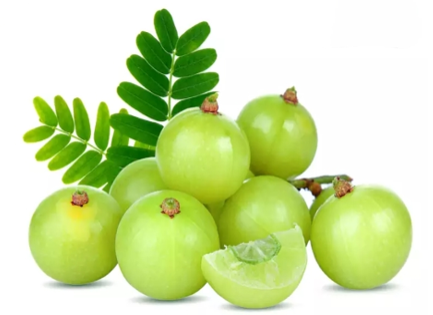
3. Shikakai
Cleanses hair
Add moreshine to the hair
Prevent grays
Provide nourishment to the hair and promote healthy and rapid hair growth .
Prevent spilt ends.
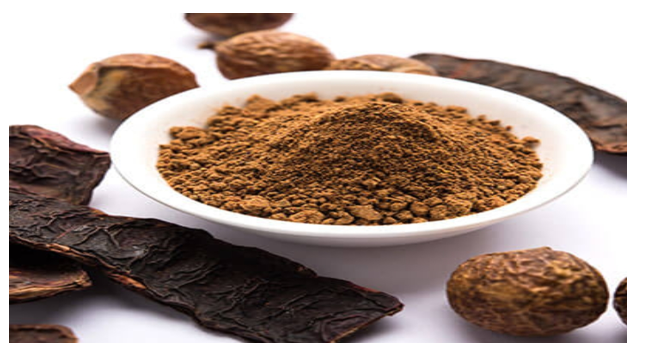
4. Hibiscus
Stimulate hair growth and lost hair volume
Condition hairs
Prevent baldness
Treat dandruff and itchy scalp
Prevent premature greying.
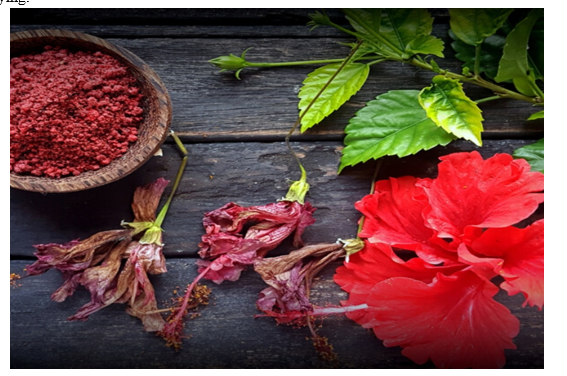
5. Aloe vera
Calm and itchy scalp
Deep cleans oily hairs
Strengthens
Aloe vera contains proteolytic enzyme which repair dead skin cells on scalp.
Promote hair growth
Smooth natural curls
Reduce frizziness
Detangle hairs

6. Lemon Juice
Add more shine
Get rid of dandruff
Split ends
Reduce hairfall
Gives natural colour to hair
Promote growth of hairs
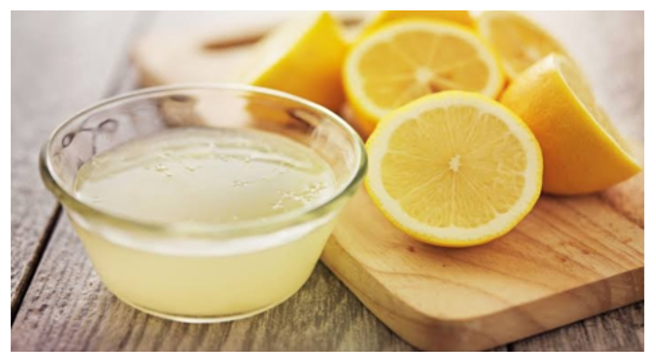
7. Rose Water
It require hair damage
Improve growth of hairs
Reduce the dandruff
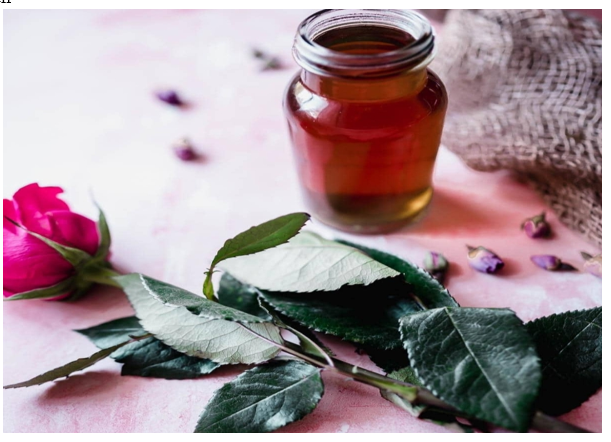
8. Ritha
It is used in preparation of shampoo
It is used as a foaming agent in the shampoo
Can be used as a cleanser for hair.
It is also used for removing lice from hair.
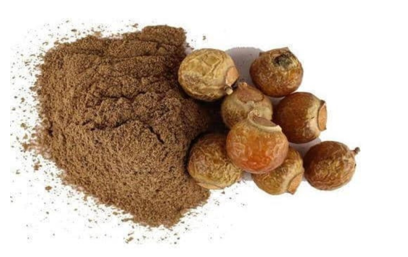
V. FORMULATION OF HERBAL SHAMPOO
Weighied all the ingredients according to the formula Soak it for overnight next morning (all ingredients become puffy and filled with water after soaking overnight).boiled ingredients in the same water on medium flame the cool the mixture and filter it. 1ml of lemon juice was also added with constant stirring .then preservatives was added and developed shampoo was stored in a suitable container and used for the further evaluation.
VI. EVALUATION OF PREPARED HERBAL LIQUID SHAMPOO
To evaluate the prepared formulations, quality control tests including visual assessment and physicochemical controls such as pH, density and viscosity were performed. Also, to assure the quality of products, specific tests for shampoo formulations including the determination of dry residue and moisture content, total surfactant activity, salt content, surface tension, thermal and mechanical stability and detergency tests were carried out.
- Physical appearance/visual inspection: The formulations prepared were evaluated in terms of their clarity, foam producing ability and fluidity.
- Determination of pH: mix 01gm of shampoo with 09ml of water and determine the pH using pH meter at 27°C.
- Determine Percent of Solids Contents: A clean dry evaporating dish was weighed and added 4 grams of shampoo to the evaporating dish. The dish and shampoo was weighed. The exact weight of the shampoo was calculated only and put the evaporating dish with shampoo was placed on the hot plate until the liquid portion was evaporated. The weight of the shampoo only (solids) after drying was calculated.
- Rheological or Viscosity Evaluations: The viscosity of the shampoos was determined by using Brookfield viscometer. 10ml of shampoo is taken in a beaker and spindle is dipped in it for about 5min. and then reading is taken.
- Dirt Dispersion: Two drops of shampoo were added in a large test tube contain 10 ml of distilled water. 1 drop of India ink was added; the test tube was stoppered and shakes it ten times. The amount of ink in the foam was estimated as None, Light, Moderate, or Heavy.
- Cleaning Action: 5 grams of wool yarn were placed in grease, after that it was placed in 200 ml. of water containing 1 gram of shampoo in a flask. Temperature of water was maintained at 350C. The flask was shake for 4 minutes at the rate of 50 times a minute. The solution was removed and sample was taken out, dried and weighed. The amount of grease removed was calculated by using the following equation: DP= 100(1-T/C) In which, DP is the percentage of detergency power, C is the weight of sebum in the control sample and T is the weight of sebum in the test sample.
- Detergency Ability: The Thompson method was used to evaluate the detergency ability of thesamples. Briefly, a crumple of hair was washed with a 5%sodium lauryl sulfate (SLS) solution, then dried and divided into 3g weight groups. The samples were suspended in a hexane solution containing 10% artificial sebum and the mixture was shaken for 15minutes at room temperature. Then samples were removed, the solvent was evaporated at room temperature and their sebum content determined. In the next step, each sample was divided into two equal parts, one washed with 0.1 ml of the 10% test shampoo and the other considered as the negative control. After drying, the resided sebum on samples was extracted with 20 ml n-hexane and re-weighed. Finally, the percentage of detergency power was calculated using the following equation: DP=100(1T/C) In which, DP is the percentage of detergency power, C is the weight of sebum in the control sample and T is the weight of sebum in the test sample 3, 4.
- Foaming Ability and Foam Stability: Cylinder shake method was used for determiningfoaming ability. 50ml of the 1% shampoo solution was put into a 250 ml graduated cylinder and covered the cylinder with hand and shaken for 10 times. The total volumes of the foam contents after 1-minute shaking were recorded. The foam volume was calculated only. Immediately after shaking the volume of foam at 1 minute intervals for 4 minutes were recorded.
- Stability Studies: The thermal stability of formulations was studied by placing in glass tubes and they were placed in a humidity chamber at 45°Cand 75% relative humidity. Their appearance and physical stability were inspected for a period of 3 months at interval of one month.
A. Benefits of Herbal Shampoo
- More shine
- Less hair loss
- Long lasting colour
- Stronger and more fortified hairs
- All natural ni chemicals
- Keep healthy natural oils.
B. Advantages of Herbal Shampoo
- Easy to manufacture and cheap in cost.
- Easily available and found in large variety and quantity.
- They did not provoke allergic reaction and do not have negative side effects.
- Easily incorporate in skin and hair.
C. Disadvantages of Herbal Shampoo
- Difficult to hide odour and taste sometimes.
- Herbal drugs having slower effect than allopathic drug hence require long term therapy.
- Manufacturing process is time consuming and complicated.
VII. OBSERVATION TABLE
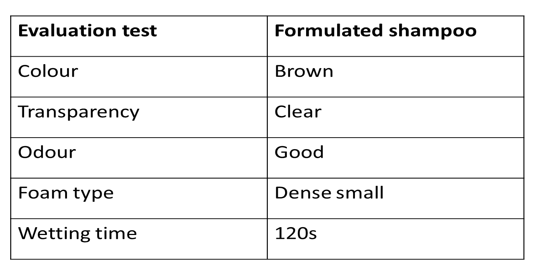
VIII. RESULT
The shampoo was formulated by admixing the equal amount of the aqueous extracts of all the ingredients with soapnut (Table 1). The above plant extract contains phytoconstituents like saponins which is a natural surfactant having detergent property and foaming property. An ideal shampoo must have adequate viscosity and many natural substances possess good viscosity. The gelatin solution (10%) behaves as a pseudoplastic forming clear solutions. Lemon juice (1 ml) added to the shampoo serves as anti-dandruff agent, natural antioxidant, and chelating agent and maintains the acidic pH in the formulation.
Conclusion
The formulated shampoo were not only safer than the chemical conditioning agent but also greatly reduce the hair loss during combining as well as strengthens the hair growth the ph of the shampoo was adjusted to retain the acidic mental of scalp the physiochemical approach used for preservation of the formulation to avoid the risk posed by chemical preservatives herbal shampoo better in performance and safer than the synthetic one will be popular with consumers.
References
[1] Eldridge J.M., Surfactant Science Series, 1997; 68: 83-104. [2] Aghel N., Moghimipour B. and Dana R.A.: Iranian Journal of Pharmaceutical Research, 2007; 6(3): 167-172. [3] Mainkar A.R., and Jolly C.I. International Journal of Cosmetic Science, 2000; 22(5): 385- 391. [4] Sharma P.P., Cosmetic Formulation Manufacturing and Quality Control 3rd ed., Vandana Publication, Delhi, 2002; 644-647. [5] Hadkar U.B. and Ravindera R.P., Indian Journal of Pharmaceutical Education Research 2009; 43(2): 187-191. [6] Gaud R.S. and Gupta G.D., Practical Physical Pharmacy, 1st ed., C.B.S. Publisher and Distributer, New Delhi, 2001; 81-105 [7] Umbach W., Cosmetics and Toiletries Development, Production and Use, 1991; 26. [8] Griffin J.J., Corcoran R.F, Akana K.K., Journal of Chemistry. 54th ed, 1977; 553-554. [9] Pooja Arora, Arun Nanda, Maninder Karan. A review on shampoos based on synthetic ingredients vis-a-vis shampoos based on herbal ingredients: International Journal of Pharmacognosy and Phytochemistry Journal of Pharmaceutical Sciences Review and Research, 2011; 7(1): 07. [10] Sharma RM, Shah K, Jankipatel. Evaluation of prepared herbal shampoo formulations and to compare formulated shampoo with marketed shampoos. International journal of pharmacy and pharmaceutical sciences, 2011; 3(4): 402-405. [11] Chanun Punyoyai, Sasithorn Sirilun, Panuwan Chantawannakul and Wantida Chaiyana. Development of Antidandruff Shampoo from the Fermented Product of Ocimum sanctum Linn, 2018,2,14.
Copyright
Copyright © 2022 Waghmode Monika Vasant, Dr. Hingane L. D.. This is an open access article distributed under the Creative Commons Attribution License, which permits unrestricted use, distribution, and reproduction in any medium, provided the original work is properly cited.

Download Paper
Paper Id : IJRASET44982
Publish Date : 2022-06-27
ISSN : 2321-9653
Publisher Name : IJRASET
DOI Link : Click Here
 Submit Paper Online
Submit Paper Online

